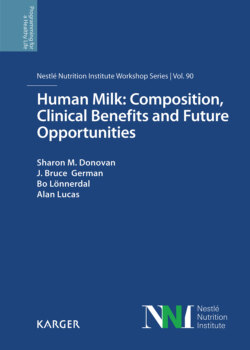Human Milk: Composition, Clinical Benefits and Future Opportunities

Реклама. ООО «ЛитРес», ИНН: 7719571260.
Оглавление
Группа авторов. Human Milk: Composition, Clinical Benefits and Future Opportunities
Nestlé Nutrition Institute Workshop Series
Human Milk: Composition, Clinical Benefits and Future Opportunities
Contents
Preface
Foreword
Contributors
Scientific Evidence for Breastfeeding
Abstract
Introduction
Breastfeeding and Mammalian Evolution
Breast Milk Composition as the Gold Standard for Infant Nutritional Needs
The Benefits of Breastfeeding Revisited
The Preterm Infant as a Model
Preterm Trials Comparing Exclusive Human Milk Feeding versus Exposure to Cow’s Milk
Necrotizing Enterocolitis and Systemic Sepsis
Mortality
Retinopathy of Prematurity
Cardiorespiratory Impact
Cognitive Development
Cardiovascular Risk Factors
Atopic Disease
Conclusion
Further Models
Overview
Disclosure Statement
References
The Biomechanics of Breastfeeding: Bridging the Gap between Engineering-Based Studies and Clinical Practice
Abstract
Introduction
What We Already Know
Engineering-Based Approaches to Modelling Milk Removal from the Breast
Validity of the Engineering-Based Mathematical Models
Key Physiological Features Not Included in Models
Which Force Is Primary in Causing Milk Removal from the Breast?
A Final Piece of Evidence
Clinical Implications of the “Revised Suckling Physiology”
Disclosure Statement
References
Summary on State of Breastfeeding in the World
Physiological Effects of Feeding Infants and Young Children Formula Supplemented with Milk Fat Globule Membranes
Abstract
Introduction
Physiological Effects of Single Components of the Milk Fat Globule Membrane
Clinical Studies on Milk Fat Globule Membrane Concentrates Fed to Infants and Children
Conclusions
Disclosure Statement
References
Human Milk Oligosaccharides: Factors Affecting Their Composition and Their Physiological Significance
Abstract
Introduction
Maternal Glycosyltransferase Polymorphisms Affect HMO Composition
HMO Composition and Maternal Diet, Gestational Age, and Physiological State of the Infant
The HMO Composition Is Associated with the Gut Microbiota in Infants
HMO Composition Is Linked to Infection Risk in Infants
HMO Composition Might Be Linked to Allergy in Infants
Insight from Clinical Intervention Trials with Specific HMOs
Conclusion
Acknowledgment
Disclosure Statement
References
Fatty Acids and Fat-Soluble Vitamins in Breast Milk: Physiological Significance and Factors Affecting Their Concentrations
Abstract
Introduction
Human Milk Fatty Acids. Description
Factors Affecting Varied Concentrations
Physiological Effects
Fat-Soluble Vitamins of Human Milk. Description
Vitamin A
Vitamin D
Vitamin E
Vitamin K
Conclusion
Acknowledgment
Disclosure Statement
References
Water-Soluble Vitamins in Human Milk Factors Affecting Their Concentration and Their Physiological Significance
Abstract
Introduction
Forms in Human Milk, Effects of Maternal Status, and Relationship to Infant Function. Thiamine
Riboflavin
Niacin
Pyridoxine
Cobalamin (B12)
Folate
Biotin
Choline
Ascorbic Acid (Vitamin C)
Concentration Changes during Lactation
Effects of Maternal Supplementation or Food Fortification
Other Factors
Conclusions
Acknowledgments
Disclosure Statement
Funding Sources
References
Human Milk MicroRNAs/Exosomes: Composition and Biological Effects
Abstract
Introduction
MicroRNAs
Exosomes in Milk
Origin of Milk MicroRNAs and Variation during Lactation
Effect of Digestion on Milk Exosomes
Cellular Uptake of Exosomes/MicroRNAs
Functions of Breast Milk MicroRNAs
Conclusions
Disclosure Statement
References
Human Milk Proteins: Composition and Physiological Significance
Abstract
Introduction
Human Milk Protein Composition
Biological Activities of HM Proteins
Bioactivities of Lactoferrin
Bioactivities of Osteopontin
Bioactivities of MFGM
Future Directions
Disclosure Statement
References
Summary on Human Milk Composition and Physiological Benefits
Early-Life Nutrition, Growth Trajectories, and Long-Term Outcome
Abstract
Introduction
Very-Low-Birth-Weight Infants
Breastfed Infants from Developing Countries – Stunting
Is Low Protein Intake during the Breastfeeding Period and Beyond a Factor That Contributes to Obesity Prevention?
Body Composition
Cohort Studies
Conclusions
Disclosure Statement
References
Early-Life Nutrition and Cognitive Development: Imaging Approaches
Abstract
Introduction
Nutrition in Early Brain Development
Iron
Choline
Long-Chain Polyunsaturated Fatty Acids
Noninvasive Imaging Approaches
Structural Development during the First Years of Life
Functional Brain Development during the First Years of Life
Gut-Brain Axis
Conclusions
Disclosure Statement
References
Early-Life Nutrition and Gut Immune Development
Abstract
Introduction
Gut Immune Ontogeny
Impact of Nutrition on Gut Mucosal Immune Ontogeny through Microbiota Shaping. Gut Microbiota Ontogeny
Mechanisms of Microbiota–Driven Immune Shaping
Early Nutrition Driving Microbiota Composition and Function
Direct Impact of Nutrition on Gut Mucosal Immune Ontogeny
Solid Food and Dietary Antigens
Vitamin A
Aryl Hydrocarbon Receptor and RAR-Related Orphan Receptor-γt Ligands
Breast Milk
Conclusion
Acknowledgments
Disclosure Statement
Funding Sources
References
Early-Life Nutrition and Microbiome Development
Abstract
The Gut Barrier and the Healthy Microbiota
Gut Microbiota: A Target for Preventive and Therapeutic Measures?
Infant Gut Microbiota: Origin and Determinants of the Composition
Optimal Nutrition for the Healthy Microbiome
The Model Is the Healthy Breastfed Infant
Determinants of Breast Milk Microbiota
Bridging Early Nutrition to Health by the Microbiota
Disclosure Statement
References
Human Milk and Clinical Outcomes in Preterm Infants
Abstract
Introduction
LOVE MOM Cohort
Subjects
Measures
Statistical Approaches
Results
Discussion
Necrotizing Enterocolitis
Sepsis
Bronchopulmonary Dysplasia
Neurodevelopmental Outcome at 20 Months Corrected Age
Conclusion
Disclosure Statement
References
Summary on Clinical Aspects of Human Milk on Infant Health Outcomes
References
Metabolomics in Human Milk Research
Abstract
Introduction
Human Milk and the Human Milk Metabolome
Human Milk and Infant Health
The Collaboration between Milk and the Developing Neonate
Conclusions
Acknowledgment
Disclosure Statement
References
Human Milk Oligosaccharides: Next-Generation Functions and Questions
Abstract
What Are Human Milk Oligosaccharides?
What Drives the Variation in HMO Composition?
What Happens to HMOs after Ingestion?
What Are Potential HMO Functions?
How Do We Interrogate the Effects of HMOs?
Disclosure Statement
References
Guiding Development of the Neonate: Lessons from Mammalia
Abstract
Introduction
Regulation of the Tammar Lactation Cycle
The Role of Milk Bioactives in Development of Specific Tissues in the Suckled Tammar Neonate. Development of the Gut
Development of the Lung
Mechanisms for Delivery of Bioactivity in Milk
Human Milk Bioactivity: Acute Response to Challenge and Potential for Breast-Programmed Development
A Comparison of Tammar and Human Databases to Identify Human Colostrum, Milk, Placental, and Amniotic Fluid Bioactives
Conclusion
Disclosure Statement
References
Milk Lipids: A Complex Nutrient Delivery System
Abstract
Introduction
Assembling Lipid Particles in the Mammary Epithelia
Milk Fat Globule Disassembly
Lipids as Metabolic Signals
Conclusions
Acknowledgements
Disclosure Statement
References
Summary on Research Gap and Opportunities
Subject Index
Отрывок из книги
Human Milk: Composition, Clinical Benefits and Future Opportunities
J. Bruce German Davis, CA
.....
Veit Grote/Germany
Berthold Koletzko/Germany
.....